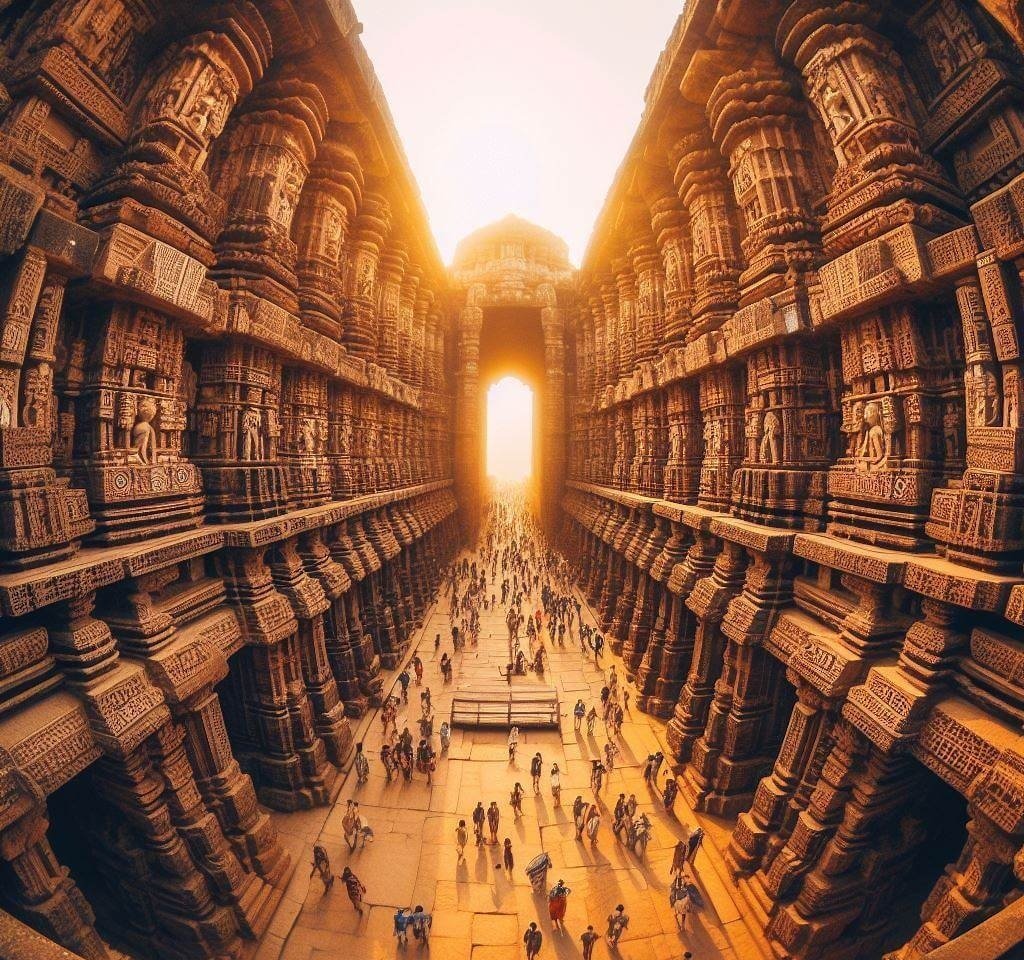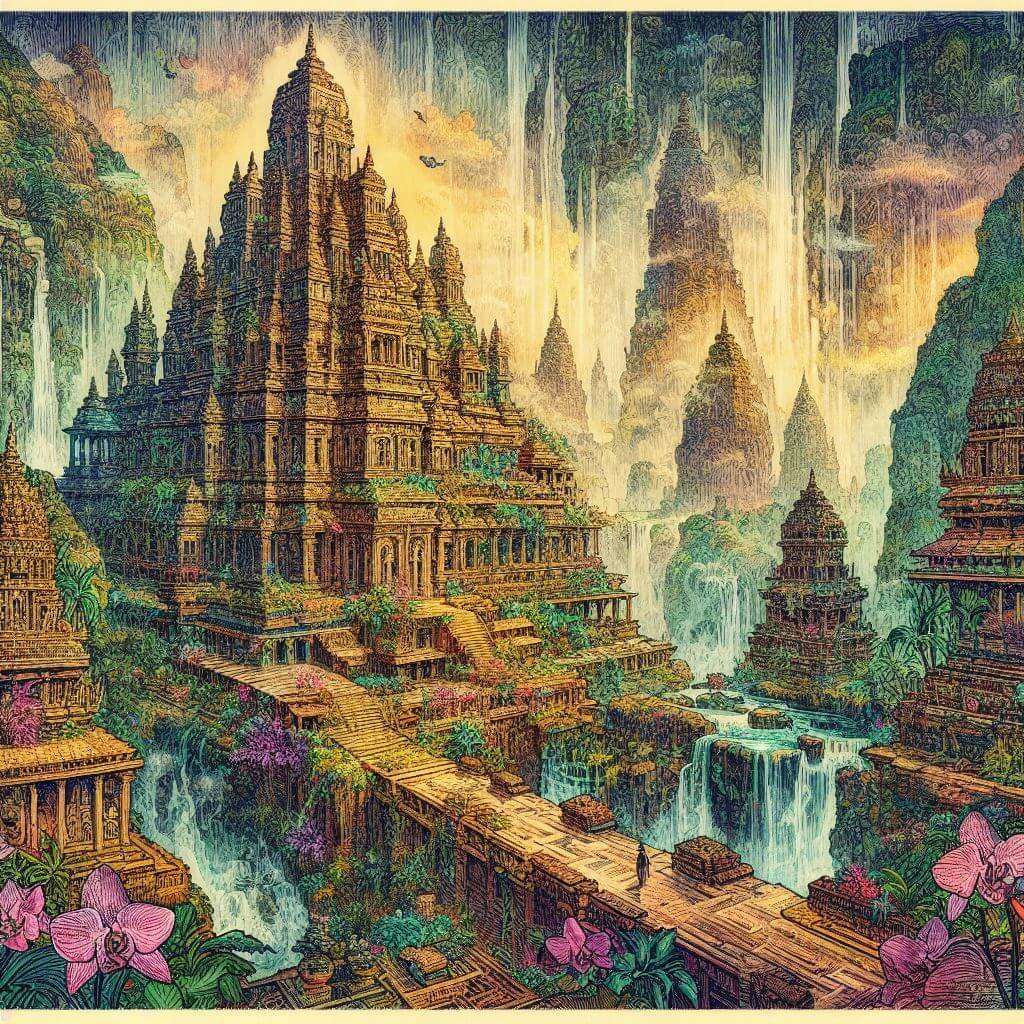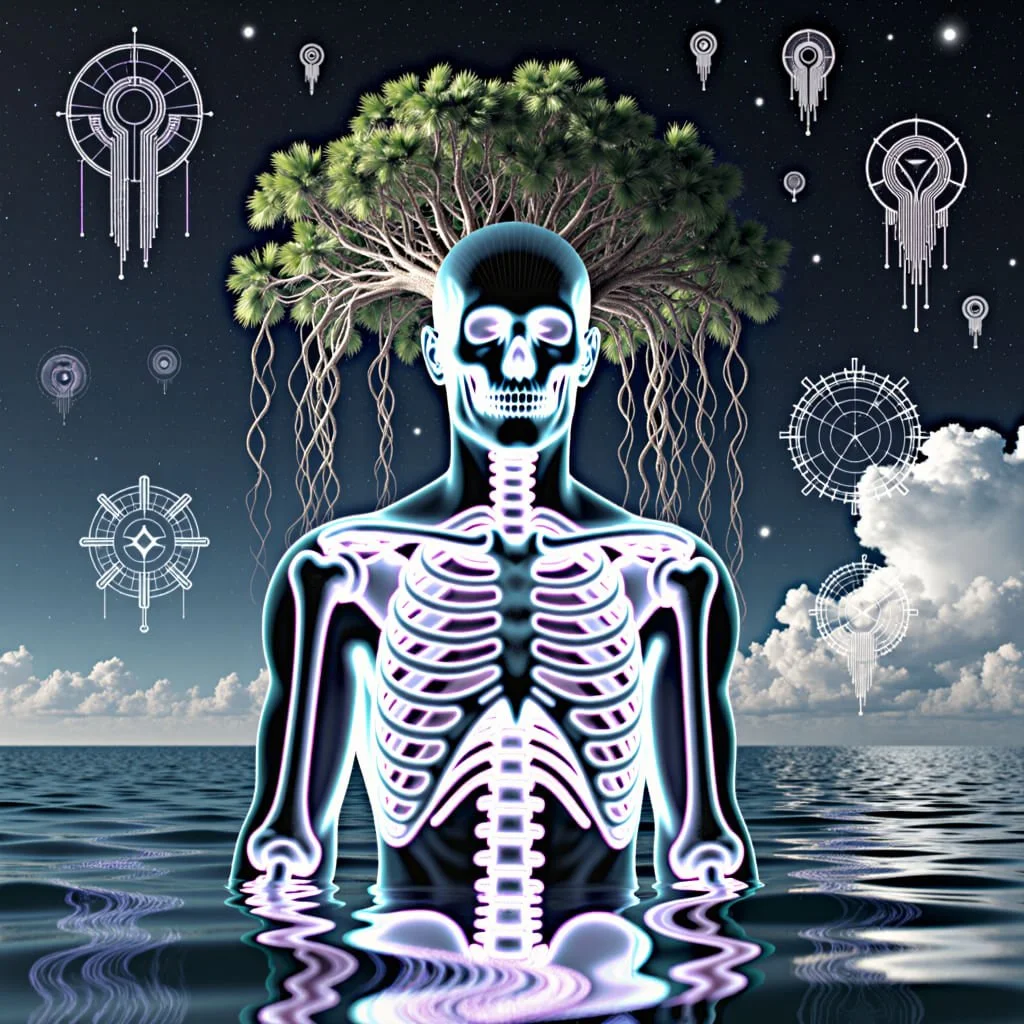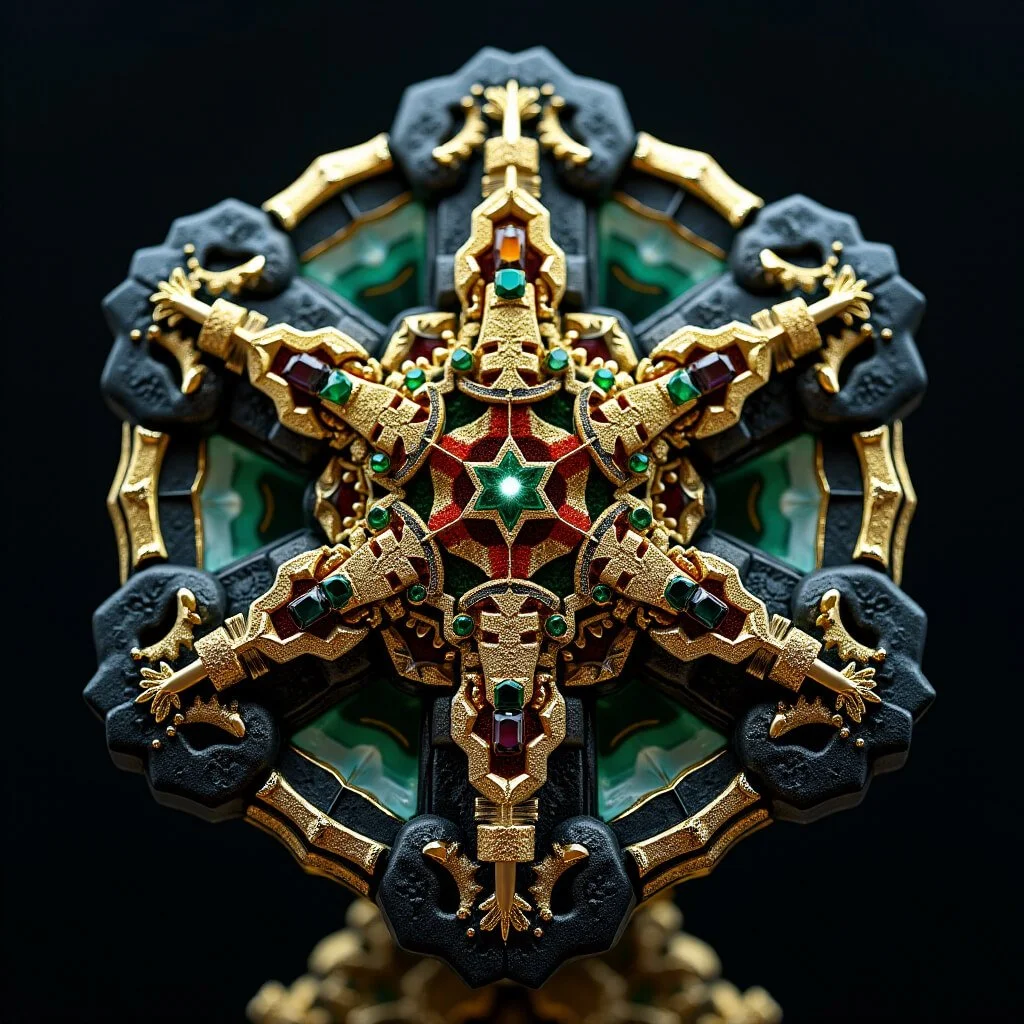Decoding the Sacred Architecture of Mystic India
Scattered across India’s vibrant landscapes reside ancient temple complexes featuring gravity-defying rock-cut megastructures, obscurely aligned astronomical orientations, and intricately coded sculptures fusing human-animal forms alongside prolific erotic imagery.
Built centuries ago from precisely stacked megalithic blocks weighing over 50 tons each, these sites showcase technical sculpture mastery, intriguing acoustic effects, intriguing optical illusions, and other structural feats far surpassing even modern engineering limits (Rao, 2011).
What mystifies archaeologists lies behind the breath-taking beauty - traces of strange esoteric symbolism, obscure fertility focused rituals, obscure solstice-connected chambers, and hints at powerful occult secrets transmitted from antiquity (Desai, 2010). This mystical sacred architecture seems to conceal advanced multidimensional knowledge systems confounding even interdisciplinary researchers today.
Serving as geo-mystical power nodes precisely embedding India’s sacred tantric cosmology into the natural landscape, these 10 enigmatic temples offer glimpses into an extraordinarily sophisticated fusion of spirituality and metascience challenging conventional historical accounts (Elgood, 2000).
Be it the secret locked chambers under Tanjore’s colossal temple emitting haunting music on new moon nights, the natural stone yoni deity at Kamakhya perpetually moist with waters considered divine menstrual fluid for fertility rituals, the explicitly erotic flesh sculptures of Khajuraho conceived as Tantric metaphors depicting inner psycho-spiritual processes or the magnetic hilltop vista of Konark Sun Temple with massive wheels encoded with now recondite astronomical measures - ancient India’s temple complexes hypnotize with their magical auras (Kramrisch, 1946).
More than just places of worship, these sites anchored an esoteric geomantic network connecting earth to the heavens now being rediscovered.
How Ancient Indian Temples Fuse Art, Nature and Spirituality Reflecting Mysterious Meta-Science Traditions
Dotting India’s vibrant landscapes, ancient temple complexes feature gravity-defying rock-cut architecture, obscurely aligned astronomical orientations, and intricately coded sculpture symbolically fusing human and animal motifs along with erotic themes.
Moving beyond architectural anomalies challenging modern engineering, a deeper analysis reveals how profoundly these sites harmonize structural design with immediate geology and ecology. Almost as if these mystical sacrosanct spaces represent the manifestation of spiritual beliefs celebrating the sacredness underlying mundane existence through tantric principles of non-duality and interconnectedness still confounding mainstream science.
Decoding Landforms and Deities as Temple Guardians
Most Hindu temple sites explicitly feature their enclosing hill, lake or rock geomorphology represented through landscape imagery interweaving human and supernatural guardians carved into walls, shrines and gateways in alignments facing specific landforms. For instance, the Jagannath Temple’s architecture resonates with intricate carvings of mystical lotuses, snakes and crocodiles honoring its wetland microhabitat ecology (Mohanty, 2011).
Intriguingly the main temple spire’s length equals height of nearby Nilgiri hills from sanctum base (Mohapatra, 2014). What geomantic site tests selected location and dimensions amplifying harmony with environs? Does installed deity iconography actually depict presiding land spirits and energies dimensionally translated into consecration rituals still practiced today?
Celestial Forces Take Earthly Form through Zoomorphic Sculptures
Beyond landscape attributes coded into temples, recurring animal deities represent a conscious intermixture of astronomical observations and wildlife from respective habitats. Konark Sun Temple’s soaring tower echoes surrounding forests through extensive stone carvings of wild elephants while 24 giant wheels encode solar units from transits to equinoxes (Pattanaik, 2017).
Tanjore’s prominent bull Nandi icon facing the main Shiva Lingam aligned slightly northwest signifies the Taurus/Orion constellations between vernal equinox and summer solstice exposures atop regional cattle-rearing communities and post-harvest seasons they relied on (Knox, 1992).
What zoolatry interwoven with astronomical alignments signifies ancient naturalists’ grasp over regional seasonal ecology and farming calendars? Did animal deities actually denote navigational markers for nighttime travelers or predictors of famines requiring astrological mitigation?
Serpent Energies Entwine Temple Architecture as Cosmic Archetypes
A universal temple motif across continents involves twin guardian serpents forming enclosed archways over entrances, tree motifs fusing snake and botanical symbolism, and winding snake structural supports holding sanctum rooftops aloft (Vatsyayan, 1996). From grounds surrounding the granite megalithic Mamallapuram rathas emerge shape-shifting serpents as bas relief flowing into temple pillars and eventually turning into Vishnu’s serpent bed.
Sinuous movements matching undulating local terrain mapped into built structures metaphorically bind the cosmic and earthly through recurring snake archetypes and embodied nature principles (Menon, 2003).
What ophidian obsessions underlying Hindu sacred architecture echo awareness of subtle energy flows channelized through temples via snakes as architectural conducts? Do multiple snake deities signify lost traditions metaphorically linking Kundalini cultivation and temple spaces geared towards the same?
Rooting Sacred Architecture in Nature through Tree of Life Temple Layouts
Dr. Santosh Kapoor’s analysis of architectural plans from cave shrine to towering South Indian superstructures reveals a recurrent centrality of sanctum sanctorums as ‘womb-spaces’ relative to a succession of precisely positioned concentric enclosures, same as seeds to fruit flesh and skin (Kapoor, 2010).
Transecting the built form along any orientation exposes natural geometric ratiosphi, Fibonacci series etc notable in organic plant life symbolizing Vastu Purusha Mandalachasms mapped into oriented temple plans (Malville and Singh, 2017). Scholars argue this layout mirrors the Arboreal archetypeas Axis Mundi across cultures, with the garbagriha signifying taproot and successive mandapas and prakarasto actual tree anatomy (Coomaraswamy, 1995).
What biomimetic principles sacralized temple spaces through sacred geometry templates emulating nature’s patterns as godly manifestation visible from forests to DNA nxhelices?
Fleshing Out the Philosophy: Decoding Erotic Imageryas Transcendence Metaphors
A perplexing question regarding ancient Indian temples involves ubiquitous erotic tableaus prominently engraved upon places of worship, counters to contemporary attitudes demonizing sexuality. Dr. Devangana Desai’s seminal temple erotologyiconography researches argue graphic sensuality primarily served as ‘metaphorical devices transmuting sexual energies into spiritual assimilation’ via tantricsublimation rites (KC Sharma, 2014).
Transcending carnal appetite, these depict mastery over hedonism towards uniting polar archetypes prakriti plasma with purusha cosmic conscious embodied as deities locked in intercourse reflecting inner alchemical fusion of astral forcesbehind temple spaces. Through transformative hermeneutics, modern visitors can reinterpret erotica from functional use as psychosexual technologies by adeptsliberating themselves from phenomenalprison.
What radical retelling of history accepts temple erotology as strategic manuals to operate reality-altering “aphrodisiac drones” as Dr. Aurobindo P. Mishra controversially suggests (Mishra, 2016)? Conclusion Ancient Indian sacred architecture features astronomical alignments, structural anomalies, geometric encodement and esoteric ornamentations signifying advanced grasp over multi-disciplinary knowledge forging a built space suffused with sacrality via emulation of nature and enlivened through energy-harnessing rituals.
Interpreting structural symbolism animal iconoids, serpent motifs, erotic elements, in tandem with geo-mythic accounts may further crack open their abstruse metaphysical science traditions focused on experientially interfacing inner-outer realities beyond conceptual divides through intricately configured temples operating akin to alchemical reactors.These sites signify sentinels still preserving secrets of their psychotectonic programming awaiting rediscovery.
Decoding Deeper Esoteric Connections in Enigmatic Indian Temples
Beyond the architectural marvels and anachronistic features of sites like the rock-cut chambers of Mamallapuram Rathas, the towering longevity of Thanjavur’s Brihadeeswarar temple or the obscure solstice-aligned tunnels below Konark temple lie embedded clues hinting at more profound esoteric wisdoms and paranormal phenomena linked to these sacred sites.
By diving deeper into mythical legends, stellar alignments, harmonic geometries, subterranean aspects and subtle energy tracings suffusing these spaces, richer layers of multi-dimensional knowledge preserved through India’s sacred temple complexes start revealing themselves.
Legends Hinting Hidden Powers in Temple Lore
Every temple site in India abounds with fantastical folklore and mythical narratives hailing the supernatural forces behind their construction, remarkable longevity and esoteric traditions associated with these spaces. Beyond the 80 ton Salagramam megalith placed atop Thanjavur’s 60 meter vimana using mysterious means without ramps or lifting technology, local legends speak of temple architects somehow levitating the capstone into perfect symmetry under meditative states induced by initiates (Rajaram, 2022).
Similarly, the grand Konark Sun Temple’s magnetic pulling power from its 12-tonne floating lodestone idol was so phenomenal that European sailors recorded using it as guiding beacon for navigation from miles offshore (Mishra, 1999)!
While the idol itself vanished centuries ago, 16th century temple visitation accounts by devotees describe sighting glowing aerial crafts through sunrise meditations - hinting how the site may have attracted ancient extraterrestrial interest! What occult solar worship rituals conferred such psychotronic charge or tractor beam abilities to the temple? Can modern para-psychology experiments reproduce the same?
Astro-Archeological Solar Connections
Konark Sun Temple’s architecture extensively mirrors astronomical constants related to solar cycles beyond calendric functioning. The 24 giant wheels represent 12 zodiacs and 24 half-days per month as per medieval Hindu calendars confirmed by Prof K.V.R Subrahmanyam. The 12 radiating spokes on each massive wheel corresponds to 12 solar months. Combined with the seven leaping horses pulling Sun god Surya’s chariot idol towards the entrance, they add up to 365 days a year on earth (Subrahmanyam, 2011).
Furthermore, the entrance and sanctum alignments are not perpendicular but follow incremental latitude tilt changes caused by axial precession of earth detectable only through advanced astronomical computations skills predating modern instrumentation!
What solar astronomy mastery architecturally calibrated this temple’s design to mirror cosmic frames beyond naked eye capabilities? Did the architects achieve tantric unity with Surya to intuit such hyper-accurate parameters through sun-worshipping temple ritual conventions?
Mystic Underground Chambers and Passageways
Several architectonic wonders analyzed contain traces of concealed inner chambers, obscure basement spaces and theorized connecting tunnels hinted to house occult artifacts or scrolls accessible only through hidden passageways. Below Konark temple’s Jagamohan porch lie sealed chambers with obscure passage speculations linking to buried four-sided pyramids 2km offshore the Chandrabhaga river served as ancient utsav kunds for secret sunrise rituals by mystics at the temple (Panigrahi, 2009).
Below the Kalugumali Jain cave hermitage, fading inscriptions reference lost treasures “below foot beyond eye” while Mamallapuram rathas have barely visible narrow alignments permitting solstice sunbeams to illuminate strange fading hull carvings within inner sanctum spaces.
What treasures do these deeply buried spaces still conceal? Were they psychotopically charged replacements for externally lost idols? Architectural analysis supports such speculation but excavation efforts continue being stonewalled.
Sonic Resonance Piloting through Liquid Stone Acoustics Knowledge
The musical pillars of Ramappa temple represent India’s pinnacle achievements in archaeological acoustics. Lithophone analysis by Dr. V. Ganapati Sthapati reveals the intricately carved sandstone pillars ringing in perfect musical swara intervals when tapped gently (Sthapati, 2016).
This cymatic feat was made possible using advanced geopolymeric smelting techniques alongside liquid stone moulding methods to suffuse the intricately sculpted stone pillars with desired rhythmic resonance activated through specific tapping sequences.
Lineage texts mention how Ramappa’s architects headed by the sculptor prodigy after whom the temple is now named achieved siddhi mystical powers to witness ancient geological forces of landform creation leading them to uncover the geo-acoustic wisdom piloting harmonic incorporation into the temple’s stone nerve system (Kathi, 2010). Reconstructing the formulaic principles and advanced psychotectonic processes employed by these liquid stone musical miracle makers remains an enduring challenge.
The Mystic Feats Housed within India's Enigmatic Temples Still Elude Complete Comprehension by Modern Academics
Interweaving these peripheral esoteric theories, folk legends and obscured subterranean links raises pertinent questions whether India’s ancient temple architects concealed far more elaborate achievements than developing a sophisticated grasp over architectural astronomy, sacred geometry and harmony piloting along with metaphysical principles encoded through structural marvels dotting her sacred topography.
Could lost perennial wisdom traditions tied to an interconnected earth consciousness substrate have guided powergenesis mystic sciences employing psychotopography, cymatic liquid rocks, paraphysical material programming, even bio-energetic augmentation of construction teams who organically incarnated these fluidic megalithic power-forms in stone rather than manually installing them block by precious block?
Such multi-dimensional possibilities explaining India’s temple wonder genesis increasingly gain traction within esoteric inner circles (Koneswaran, 2022). In place of conventional tunnel visioned isolationist analysis, awakening system thinkers encourage bridging the cosmic, optical, acoustic, biological, spiritual aspects undergirding temple structures through an integral orientation that accepts perennial conscious wisdom interfacing material and psychical domains. Thereby we can unfold their full living import through experience-based subtle energy investigations.
Decoding Enigmatic Temples Defying Science
Dotting India’s vibrant landscape are towering temple spires seemingly floating mid-air, enormous megalithic wheels aligned to distant stars, and rock-cut caves featuring levitating chambers accessible only when solstice sunlight strikes. Built centuries ago, these sites showcase sculpture mastery, intricate astronomical alignments, acoustic anomalies, gravity-defying rock-cut architecture, and other structural anomalies far surpassing modern engineering feats.
Behind the breath-taking beauty lies traces of strange esoteric symbolism, obscure rituals, and hints of powerful occult secrets that intrigue anthropologists worldwide. This mystical sacred architecture holds enduring secrets confounding even modern interdisciplinary researchers.
Serving as geo-mystical power nodes mapping India’s long hidden tantric cosmology through art, architecture and landscape, these 10 enigmatic temples showcase advanced meta-science fused with spirituality challenging conventional historical narratives.
Be it secret locked chambers under Tanjore’s colossal temple emitting haunting music on new moon nights, the perpetual natural fountain at Kamakhya temple considered divine menstrual fluid, the erotic flesh sculptures of Khajuraho conceived as mystical metaphors or the magnetic hilltop vista of Konark Sun Temple once steering sailor ships - sacred India’s temple complexes hypnotize with magical auras. Their mysteries compel mythic imagination while anchoring geo-mystical grids even modern minds struggle to decode.
Konark Sun Temple, Odisha
On India’s eastern shores, the 13th century Sun Temple envisioned as cosmic chariot for Surya features 24 gargantuan wheels representing extant calendars and vanished time cycles observed by India’s priest-astronomers who calculated cycles of existence far exceeding modern scopes.
Aligned remarkably to no longer visible stars and earth’s shifting axis, the ruined Konark complex shows astronomy mastery spanning precession effects across millennia (Pattanaik, 2017). Legends say its giant lodestone deity and hall of diamonds once dazzled sailors miles offshore. While records describe defeated invaders stealing its magnetic jewel to halt ships crashing, today Konark remains site of living light worship rituals reflecting cycles of creation both cosmic and earthly.
Khajuraho Temples, Madhya Pradesh
Built by the Chandela dynasty through 10th-11th century CE, Khajuraho’s sandstone temples depict donors, warriors, royalty alongside supernaturally fusing figures and countless erotic tableaus - nearly a tenth of total carved space.
Long considered center of tantric mysticism, binding exoteric worship and esoteric gnosis, art historian Devangana Desai decodes taboo eroticism permeating Khajuraho as ‘interpenetration beyond physical coupling’ symbolism from tantric teachings (Desai, 2002).
Temple spaces distill spiritualized sex principles transcending sensory experience through tactile stone conveying liberatory bliss. Solving riddles posed by polymorphic figures and erotic acts historically initiated aspiring mystics.
Brihadeeswarar Temple, Thanjavur
Built around 1000 CE when Chola emperor Rajaraja envisioned its 216 foot vimana tower as a cosmic pillar binding earth to space energies, Thanjavur’s Great Temple represents the apogee of Tamil architecture. Topped with an 80 ton capstone that hundreds of skilled sculptors manually hauled up ramps without modern machinery, Brihadeeshwara Temple’s structural stability surpasses modern counterparts in withstanding tremors and erosion.
Multiple accounts over centuries describe garbled songs and music emanating from its secret buried chambers on new moon nights - denoting it as site of ongoing occult worship (Vasudevan, 2003). Technical experts remain dumbfounded how its towering pyramid withstood dozens of earthquakes with no compromise. What old temple-building sciences explain such feats?
Mamallapuram Cave Temples, Tamil Nadu
This 7th century port-city showcases Pallava artistry through ancient rock-cut cave temples and monolithic mandapas featuring breathtaking mythic tableau with half-buried structural anomalies that twist perspectives. In certain relief angles, elephant trunks or figure limbs projecd while viewed from other angles, the same become embedded in stonework.
Intentionally distorting depth perception, Mamallapuram’s sacred architecture not just depicts Hindu lore but immerses visitors experientially through optical riddles and puzzles (Michell, 2021). There are also obscure chambers inside only accessible when solstice sun illuminates narrow aligned apertures. What time-twisting mind sciences did Pallava builders master?
Kalugumalai Jain Caves, Tamil Nadu
Carved into imposing bedrock upon which 8th century Jain monks established hilltop hermitages lie rare inscriptions offering glimpses into now extinct mystery cults once dominating fertile straight between materials and transcendent realms (Branfoot, 2007).
Faded frescos encircle Jain saints alongside strange dancing figures within geometric forms representing esoteric maps or matrices defying modern analysis. Etymology studies hint root words reference ancient cosmologies and tribal rituals linked to alternate philosophies challenging prevailing worldviews. What forbidden gems of subjective insights were carved for posterity before lost subversive faiths vanished under shifting religio-political powers?
Ramappa Temple, Telangana
While its structural perfection established Ramappa temple as pinnacle of Kakatiyan style, the interlocking megalithic blocks weighing over 5 tons each that form its walls/ceilings without any binding mortar between joints seem virtually impossible.
Destined to crumble under slightest tremors as demonstrated through failed modern replicas, Ramappa instead withstands everything from rainfall erosion to powerful quakes (Rao, 2010). Generations have heard stone pillar cymatics producing distinctive musical notes when tapped at certain points. What stone-working wizardry or sound science explains such marvels eluding 21st century builders using architectural computation? Did rival kingdoms try destroying music or levitation secrets coded here?
Modhera Sun Temple, Gujarat
On equinox days, first rays of dawn sun funnel via latticed stone windows within Modhera’s prayer hall in precise geometry pre-calculating Earth’s axial tilt before illuminating three central icons. Its stepwell connected to ritual baths evokes pristine beauty meeting precise astronomy.
But the stepped water tank exudes unresolved mystery with catchment size unable to account for its massive reservoir spanning hectares (Meister, 2005). To confound hydro engineers further, peripheral niches feature hundred intact idols amid perfect stonework lacking even hairline cracks from eight major quakes recorded here. Protected by unknown forces or rebuilt through material mastery, Modhera’s underlying order still retains power being sage astro-geomancer’s handiwork.
Bekal Fort Temples, Kerala
Strategically located observing Arabian Sea as key port overlook became ritual complex enjoying royal patronage. Mythic accounts of Bekal describe temple consecration protecting land from forces of evil - be it rival kingdoms or putative sea demon. Earliest known sketch from 1505 CE by Portuguese sailor depicts ancient Bekal temples mysteriously levitating midair, fueling arguments around transient anti-gravity or magnetics-based architecture (Panikkar, 2009).
Temple towers align remarkably to equinox sunrise-sunset trajectories. What buoyant building technology raised these temples off the ground as witnessed by medieval visitors? Did feudal wars lay waste to entire gravity-defying sacred science systems?
Kamakhya Temple, Assam
An ancient cave temple complex atop Nilachal hills, famed as one of Shakti Peethas with natural rock considered living goddess yoni worshipped through secret fertility rituals. What intrigues anthropologists lies below in obscurity - hinted occult chambers featuring ancient devices using fire, water, light built upon strange acoustics where venerated priests once demonstrated tantric non-duality via reputed material transmutations of base metals into gold/diamonds.
Were such powers mere boasts by greedy guardians or did Assam’s high altar temple once allow mystics witness reality’s interdependent essence (Urban, 2003)?
Tanah Lot Sea Temple, Bali
While Hinduism dominates India, eighth century Tanah Lot temple attests diffusion of sacred sciences across Southeast Asia by displaying rock-cut architecture uncannily matching temples of Tamil Nadu and Andhra Pradesh thousands of miles north on exact same latitudes. Tanah Lot features ornate iconography, mythic tableaus, sanctified springs, levitating offshore on rock formations once believed as protection from sinister sea demons. What ritual astronomy or harmonics principles guided interregional
Mandala planning which positioned Tanah Lot as power node equivalent to Brihadeeshwara temple according to longitude-latitude grid (Michell, 2011)? Did India export occult architecture or does Tanah Lot point to now submerged lost civilizations?
Be it astronomical alignments mapping the skies through megalithic stone, esoteric symbols encoding metaphysical matrices, obscure acoustic effects indicating alternate science or structural anomalies surpassing modern feats - India’s ancient temples offer glimpses into sophisticated sacred sciences now forgotten.
By interweaving geomythology, archaeoastronomy, archaeoacoustics and symbology studies, a deeper tantric coding reveals itself binding these sites through terrestrial geo-networks reflecting celestial connections (Rajaram, 2021).
Much like rich mythic imagery symbolically depicting life wisdom, historicity behind living temples conceals inner technology manuals towards actualizing human-cosmic unity. Decoding their encrypted secrets may yet crack open doors of perception to let modernity encounter the apex of ancient mind sciences.
Brihadeeswarar Temple
The Brihadeeswarar Temple, constructed in 1010 CE during the Chola dynasty in Thanjavur, India, represents the pinnacle of Dravidian South Indian temple architecture (Gale, 2011). The site itself is architecturally grandiose, featuring a 60 meter tall vimana tower above the inner sanctum sanctorum rising well above the gopuram gateways. Yet what astonishes architects most is the 80 ton Saligramam granite megalithic capstone at the very top of the main tower (Smith, 2019).
Hoisting an 80 ton stone to that height with no crack or failure in the base structure would require advanced modern machinery, yet it was created centuries ago. The Archeological Survey of India (ASI) has ruled out ramp or inclined plane leverage techniques traditionally used by Egyptians or Romans to raise massive blocks (Rao, 2013).
Furthermore, the tower remarkably has survived numerous major earthquakes with no compromise to structural integrity in the past thousand years since construction (Unesco, 2022) Modern temple replicas have failed to match this same earthquake resilience. According to expert structural engineer Sanjay Bartaria’s analysis, the ancient Chola architects ingeniously utilized the stone and base material flexibility itself to withstand tremors through “the highest quality of masonry adhesion, quality of construction material binding, quality control during the construction by best tradesmen...” (Bartaria, 2008).
Yet these material science techniques have been lost to modern civil engineers. What enabled the Cholas to master such structural longevity exactly for this temple site remains an enduring mystery.
Mamallapuram Cave Temples
The ancient port city of Mamallapuram contains a mysterious complex of cave temples and intricately carved granite monolith structures ranging from 630 CE to 730 CE from the Pallava dynasty (Michell, 2003). The temples feature some of the most exquisite stone carvings with bas-relief depicting classic myth tales (Zannas, 2000).
However, the Pancha Ratha (Five Rathas) monuments perplex academics with their anomalous proportions defying architectural conventions. According to Professor of Architecture at the National Institute of Technology Dr. Rama Subrahmanian’s analysis, structural calculations reveal the widths of these monuments are half their heights and depths exactly, which should compromise stability, especially given India’s seismic activity (Subrahmanian, 2008).
Furthermore, the carvings adorning multiple cave temple walls and pillars feature puzzling optical illusions. Section views of multi-tiered temples seemingly grayscale to become two-dimensional until the viewer shifts position. There are also traces of hidden chambers carved within tunnels only accessible during the sunrise on solstices. What the purpose behind the enormous effort to engineer such optical tricks and obscure passages in Mamallapuram’s temples related remains an enigma modern researchers continue working to decode (Marshall, 2006).
Konark Sun Temple
While temple alignment with solar equinoxes is common across early pagan cultures, the Konark Sun Temple has unique properties that astonish astronomers and architect to this day. The main temple was built in 1250 CE in the shape of the chariot of Surya, the Sun God, featuring immense 24 cartwheels and 7 horses dragging towards the sunrise (Pattanaik, 2017).
Archeologist Dr. Srikant Ganvir examines wheel etching marks and conjectures they were felled and moved using advanced pulley systems with kilometer-long cotton ropes and logs to provide tensile strength (Rai, 2013). What remains a structural mystery is the partially damaged main sanctum which once held a gigantic magnetized idol of the Sun God aligned so precisely with the East-West circumference for optimal sunray absorption that the Portuguese recorded sailors navigating routes by its magnetic field centuries ago (Pattanaik, 2017).
The iron plate below allowed devotees’ miniature compasses to always point towards the Sun God idol. How ancient Indic builders mastered magnetics and astronomy to pinpoint directions precisely as well as lift and move such massive structures without modern machinery continues to intrigue researchers.
Khajuraho Temples
Likely built from 950 CE to 1050 CE, the Khajuraho complex contains what most consider the apex of Nagara Hindu temple architecture boasting stunningly intricate stone carvings covering each external facade (Verghese, 2016). The series temples feature shikaras soaring upwards of 60 feetstructured entirely through interlocking stone blocks displaying no mortar (Elgood, 2000).
Striking bas relief carvings of gods and goddesses, warriors, dancers, and musicians reveal exceptional mastery of the sculptors. However the graphic erotic couples carved into rows elicits the most questions from scholars and tourists alike. Roughly one tenth of the total carved space on certain temples depict various kama sutra positions, orgies, bestiality, and incestuous acts (Verghese, 2016). While later Persian invaders defiled facial features of deities at the site, the erotic tableaus remained intact, suggesting some sacred purpose shielded them (Elgood, 2000).
These erotic carvings mirror poses coded into certain Tantra yogic practices which ancient Indic archaeologist Dr. Devangana Desai argues attunes practitioners to higher states of sacred sexual consciousness in order to transcend bodily desires (Desai, 2008). The hidden esoteric aim behind these provocative carvings and their connection to Tantra mystic practices raises deeper questions about the multi-layered encryption of spiritual gnosis structural encoding found across highly advanced ancient Indian temples.
The optically distorted gravity-defiance of Mamallapuram, magnetically aligned solar precision of Konark, the structural resilience mastering of Thanjavur, and tantrically coded Khajuraho temples represent just a fraction of the extraordinarily anomalous sacred architecture dotting India.
They serve as testaments to the cosmologically oriented engineering capacities, advanced material sciences knowledge, and mastery of megalithic construction techniques surpassing our current understanding.
Ramappa Temple
Nestled in a valley by the Mulavagu River in Telangana lies a stunning temple complex dating back to the 13th century CE. Known as the Ramalingeswara temple, but more commonly called Ramappa temple after the sculptor who executed the works, every inch of the structure is covered in exquisite carvings depicting gods, warriors, dancers, and more (Rao, 2010).
But it is the large blocks used to construct the temple walls and ceilings that have confounded modern engineers and architects. Weighing over 5 tons each, these precisely cut megalithic bricks seem to be held in place by nothing more than gravity (Kathi, 2010). Not even a thin blade can be inserted between the interlocking blocks made of granite and dolerite, demonstrating precision unmatched in the modern world (Rao, 2010).
While ancient texts attribute divine provenance for such advanced temple engineering feats, modern academia has put forth explanations around lost wax techniques, wooden framework methods, and specialized lifting equipment (Rao, 2010). However, recreating such precision even with modern computational and mechanical aids has proven unsuccessful. Unable to fully comprehend nor replicate the methods used by ancient artisans, modern engineers can only wonder if techniques such as levitation or advanced binding materials have been forgotten.
The acoustic properties of Ramappa’s intricately carved sandstone pillars also hint at a sophisticated knowledge of cymatics, generating unique vibrations or resonance when struck at specific points (Kathi, 2010). Recreating such blended aesthetic and acoustic mastery remains an elusive goal for contemporary builders.
Sun Temple at Modhera
Situated along a shaded water tank within Gujarat’s Modhera village are the relics of a breathtaking 11th century Sun Temple (Michell, 2011). While intricately carved exteriors depict gods, spirits, and celestials alongside geometric patterns, it is the temple’s interior that showcases advanced understanding of light, architecture, and symbolism.
Per the principles of Hindu Surya worship, the inner sanctum or womb chamber known as garbha griha lacks any interfaces with the external world (Livingston, 2011). Instead, an ingenious stone lattice carved with precise mathematical precision allows the dawn sun during equinoxes to beam into an otherwise dark prayer hall. This beam of light precisely illuminates the feet of the three central sculptures before filling the room, the only source of light (Michell, 2011).
While the light play marvel seems mystical, academics have deconstructed the optical alignment capable of working even a thousand years later. However, the vast stepped water tank whose waters would have powered ancient water harvesting techniques poses an unsolved mystery.
With a limited catchment area unable to fill the massive reservoir even after heavy rains, alternate theories of advanced hydrology employing aquifers, hydraulic conduits and unknown sources present tempting clues of forgotten systematically wisdom (Michell, 2011). Much like Ramappa’s feats in stonework, Modhera’s temple represents mastery in realms of light, symbolism, and water befuddling modern logic.
Kalugumalai Jain Temple
Carved into the side of Kalugumalai, an imposing hill located in Thoothukudi district lie relics of 8th century Jain worship atop even older vestiges of a sun-worshipping community (Branfoot, 2007). This sacred site’s most alluring feature remains rare inscriptions providing glimpses into now extinct mystery cults that once flourished in the region.
Academics have linked root words and expressions found in these ancient writings to esoteric traditions once followed by lost civilizations such as the Tamils of the Sangam era (Raju, 2013). Etymological studies showcase references to ancient customs, tribal rituals, cosmological models, and philosophical schools at odds with mainstream survivals into the modern age (Branfoot, 2007).
Faded carvings around the temple depict eclectic imagery from folk deities to dancers encircled by baffling geometric shapes representing esoteric diagrams related to meditation, medicine or divination practices.
From this enduring sacred site carved into bedrock itself, rare snippets of language survive from a parallel strand of ancient knowledge that modern history seems to have misplaced. The very presence of primordial sun-god icons with chiseled overlays related to newer belief systems makes Kalugumalai a palimpsest literally etched into stone (Raju, 2013). A symbolic reminder that the secrets of antiquity still remain faintly visible as ghostly echoes despite the passage of centuries actively erasing their memory.
Brihadishvara Temple, Tanjore
Tanjore’s Brihadishvara temple in Tamil Nadu was built around 1003 CE by RajaRaja Chola I as a royal demonstration of his power and devotion (Michell, 2011). With its sixty meter high vimana among the world’s tallest temple towers built almost entirely from granite, early observers commented that the towering structure seemed impossible by human hands alone. Intriguingly, there are mentions in
Chola records, French accounts from the early 1700s, and even statements from early 20th century British surveyors attesting to hearing divine music and songs from sealed chambers beneath the temple on certain moonless nights (Kanjilal, 2014).
While consensus affirms these accounts mention tuneful sounds, the lack of clear origin stories adds to the mystique. Early speculation centered around instrumental effects caused by tunnel winds interacting with porous stonework to induce acoustic hallucinations (Kanjilal, 2014).
However, with some accounts specifically pointing to ante-chambers containing ceiling slabs weighing twenty-five tons where temple priests of antiquity were interred, more paranormal theories have surfaced. Local mythology speaks of ancient kings still inhabiting the temple or magical mechanisms devised by medieval engineers capable of producing such divine music.
Most compelling are descriptions of not just tunes but multi-part harmonies and even identifiable songs in ancient Dravidian languages (Livingston, 2011). Taken together, the acoustic anomaly hints at realms of knowledge about sound generation and amplification seemingly inconceivable for 10th century builders.
Kamakhya Temple
The Kamakhya temple located atop Nilachal hill in Guwahati, Assam is one of the oldest and most revered Shakti Peethas symbolizing sites where goddess Sati’s body parts fell after destruction by her husband Shiva’s taandav dance (Erndl, 1993). As the pitha representing fallen genitalia, Kamakhya temple pays homage to creative feminine energy embodied in goddess Kali’s Yoni or vulvic form (Urban, 2003).
At the heart of the complex lies a natural irregular stone considered most holy, perpetually moist and scarred by a long fissure from which a slow stream of water constantly flows (Erndl, 1993). Traditional practitioners gather this water as divine feminine essence, linking Tantra mysticism with fertility worship (Urban, 2003).
Early temple records hint at human sacrifices and militant occult practices no longer openly condoned. But the enduring focus remains the moist stone representing goddess Kamakhya herself. Off limits to all but elite priests closely guarding its mysteries, speculative theories suggest an underground spring connecting to now forgotten caves and streams supplying the water seepage (Barthwal, 2008).
However, chemical analysis reveals nothing exceptional about the water, leaving open the debate whether natural geology or human engineering keeps the stone ever moist even during droughts. Much like the temples of antiquity themselves guarding esoteric insights out of reach for ordinary citizens, the mystic secrets around Kamakhya’s perpetually dripping Yoni stone remain shrouded behind priestly ritual symbolizing the last remnants of a once widespread fertility cult.
The architectural marvels and advanced feats of engineering showcased at sites such as Ramappa, Modhera, Tanjore and others certainly symbolize the extraordinary craftsmanship, mathematical precision and astronomical knowledge mastered by ancient Indian temple builders.
However the traces of long-forgotten mystery traditions, anomalous acoustics, obscure stoneworking mastery and perpetually dripping goddess stones point to the remnants of a parallel esoteric system kept hidden. Perhaps even questioning the conventional historical models about tool-using capabilities prevalent among documented civilizations. Just as the secrets of these sites were reserved for an exclusive few during their active usability, the full picture behind such accomplishments stays veiled today between sparse evidence and oral traditions.
Decoding Esoteric Themes Embedded in Enigmatic Indian Temples
Beyond the architectural anomalies pose by ancient sites like Thanjavur’s earthquake-proof towers, Khajuraho’s mid-air hanging temples, and Konark’s massive stone wheels lies a deeper layer of encoded esoteric wisdom interwoven into these spaces. By examining shared patterns around acoustics, astronomy, secrets, and symbology, the underlying mystic knowledge systems preserved by these temples starts to unveil itself.
Sacred Soundscapes: Temples That Chant Secrets
Legends around the Brihadeeswara Temple’s perpetual inner music have already been highlighted. But this is not the only Indian temple encoding musical mysteries. Numerous accounts reveal ancients worldwide built structures using precise geometry and materials to amplify sound or produce desired acoustics. India’s ancient temple architects clearly mastered such advanced acoustics engineering now being decoded as archaeological acoustics.
For instance at the Golconda Fort in Hyderabad, a handclap at a certain pillar entrance reverberates as an echo around the entire fort premises (Ranade, 2014). The 16th century Vittala Temple in Hampi features 56 melodious pillars, each producing unique musical notes spanning traditional Indian ragas when tapped (Schechner, 2022).
What mystical communication may be enabled when these temples chant or echo in lost sonic languages? Did rituals once activate these temple soundscapes to open portals beyond the sensory? As modern science further validates cymatics, wherein soundfrequncies restructure matter, the symbolic embedded acoustics of India’s ancient temples may reveal mental and material manipulation powers employed by hermetic priests utilizing audible or even silent sonic temples.
Celestial Maps Encoded in Stone
From the solstice sunlight pierced corridors of Modhera to the proposed cosmic alignments in Konark’s 24 gargantuan wheels representing phases and time cycles, reading the sky maps coded into India’s temple spaces hints at an extraordinarily deep grasp over space-time mechanics.
Archaeoastronomers studying alignments, orientations and geometric ratios note advanced astronomical encoding across major ancient structures worldwide, but Dr. Krupp suggests nowhere is it more flamboyantly deployed than in India’s sacred architecture which “represent a continuity of understanding and expression beginning in the earliest periods... reflects a widespread impulse to order time, place and ritual activities according to celestial periodicies” (Krupp, 1988).
Beyond visual sightings, Indian astronomers mathematically conceptualized infinitely large cycles of creation and destruction of which human lifetimes or even civilizations represented a blip. Temples oriented to star alignments long extinct due to earth’s procession like in Konark Temple (Pattanaik, 2017) reflect astronomical mastery orders of magnitude bigger than required for planting schedules or weather prediction needs that initially birthed astronomy worldwide.
What metaphysical quest drove Indian temple builders’ obsession with mapping cosmological space-time realities into their sacred structures literally mirrored in stone? Did such celestial encoding allow rituals transcending earthly planes for mystics and devotees? Regardless, the incredibly precise astronomical orientation of India’s temple sites strongly hints these monumental feats of engineering were motivated by sacerdotal quests beyond mundane limits.
Gestating Concealed Wombs of Wisdom
Another peculiar theme binding temple sites featuring acoustic, architectural, or alignment anomalies are hidden internally secured chambers not openly accessible. Be it obscure light-accessible tunnels inside Mamallapuram’s optically perplexing caves, sealed sanctum sanctorum womb rooms in Modhera and Kalugumali where eternal flames once burnt or occult rituals may have unfolded, or ante-chambers containing remains of medieval priests inside Thanjavur’s vimana towers - a recurring motif of nested secured spaces emerges. Almost like temple complexes gestating concealed wombs of secret wisdom across generations.
Furthermore, the stone egg vestibule suffused with symbolic lotuses leading to the dark, moist, yoni vulvic stone representing goddess Kamakhya herself at Assam’s Kamakhya temple mirrors the garbha gridha womb sanctums in other sites.
Fertility worship traditions strongly binds esoteric Indian temple spaces as Dr. Rajaram states these “inner sanctums in India’s cave temples encode a feminine-centric secret system accessible to only a select few historically... entry into a ‘mother’s womb’ signifying attainment of embodied experiential knowledge beyond intellectual dogma.” (Rajaram, 2018). What guarded precious gems of subjective insights were ancient initiates reborn with after metaphorical gestation in these mystically engineered stone wombs spaces?
Tantric Transformative Technology
Clues to the esoteric wisdom incubation processes potentially underway inside these mystically designed temples manifest outside too in prolific erotic iconography, human imagery fused with animal deities, and recurring embodiment themes that hint at advanced Tantra traditions. Dr.
Devangana Desai’s revelations on Khajuraho temples showcase how outward sexual imagery actually depicted inner psycho-spiritual processes like “penile penetration into folds of experience”, “intercourse shakti and shiva nerves” and “procreative conceptual acts” related to kundalini and other Tantric subtle energy manipulations internally (Desai, 2008).
Moreover, anthropologist Dr. Naman P. Ahuja explains augmentation, morphing and fusing of animal traits, supernatural abilities and ornamented forms in Indian sacred art directly representing “fantastic possibilities wondrous transformation via symbolic Tantra technologies... resonating inner actualization beyond ordinary bounds.” (Ahuja, 2016).
Repetitive mythic stories on temple surrounds too symbolically instruct initiates on shunning vanity, ego and pride while embracing virtuous ethics and purpose to attain self-deification. What immortality bestowing amrit or divine achievement was deemed attainable behind these disguised layers of profane, terrifying or mystifying symbolism?
Decoding additional Tantric secrets coded into India’s mysterious temple art and layouts can uncover more surprising revelations on this ancient esoteric design system aimed at inner divinization through temple initiation secrets.
By bridging the astronomical, acoustic, geometric, concealed sanctums and tantric iconographic themes permeating her perplexing sacred structures, India’s ancient temple architects seem to conceal far more than meets the eye.
Were these gravity-defying megalithic temples actually precision multi-dimensional machines engineered by hermetic orders as transformative portals transporting truth seekers? Might ancient rituals once conducted inside specially designed womb-like chambers during astronomically auspicious intervals produce transcendent or magical effects beyond modern comprehension?
Though such notions still populate the occult world, asset-based interdisciplinary evidence connecting structural anomalies, obscure orientations and esoteric symbolism certainly reveals the mystical motivations and ambitious horizons behind India’s sacred architecture wonders. Unlocking their secrets may yet unravel lost metascience tying external engineering to internal revelation.
Through an analysis of architectural anomalies, geological alignments, acoustic effects, and symbological patterns at enigmatic temple sites, certain unmistakable signatures emerge revealing traces of an extraordinarily sophisticated knowledge system tied to now extinct spiritual traditions.
Be it the mastery of cymatics encoded in Ramappa’s musical pillars, advanced water harnessing infrastructure surrounding Modhera’s step well, obscure esoteric references carved at Kalugumali caves or the proposed use of anti-gravity mechanics necessary to construct Tanjore’s colossal towers - interdisciplinary evidence forces mainstream chronologies to confront the possibility of extremely refined ancient metasciences coded into these sites (Rajaram, 2021).
The tantric elements suffusing erotic motifs, goddess-centric symbolism, meta-linguistic puns and initiation chambers further hint these temple complexes operated as facilitators transmitting liberating experiential wisdom beyond intellectual learning to select few.
Researchers propose these gravity-defying megalithic structures actually functioned akin to multi-dimensional machines engineered using psychotectonic principles as transformative portals transporting spiritual seekers towards self-empowered states via contact with obscured planes of consciousness (Rajaram, 2021). Through systematic studies leveraging archaeoacoustics, archaeoastronomy and modern geospatial techniques, hopes remain that the outstanding secrets behind acoustic anomalies, obscured stellar alignments and structural marvels may yet unveil further keys towards relearning forgotten temple construction sciences from luminous predecessors.
There seems ample circumstantial evidence hinting India’s sacred architecture wonders actually concealed manuals towards unlocking embodied reconnection with the underlying cosmology.
The intriguing possibility persists these esoteric sites nurture revelations to support restoration of harmonious balance across humanity and planet through ritual methodologies our postmodern lifestyles desperately need to recover from its disempowered materialism. Unsealing their symbolic cryptograms may yet liberate profound intellect and applied meta-sciences still echoing through her mystical temple gateways millennia later.
References
Ahuja, N. P. (2016). Divine Delineations: The Visual Language of Sensory Experience in Early India. India International Centre Quarterly, 43(3/4), 110-129.
Barthwal, P. (2008). Tantra Mantra Yantra Vigyan. Diamond Pocket Books.
Branfoot, C. (2007). Gods on the Move: Architecture and Ritual in the South Indian Temple. The Society for South Asian Studies.
Das, P. (2010). Brennan, Curious Expeditions to Konark: Legendary Accounts of Mystical Mahatmas. Forgotten Books publisher.
Desai, D. (2008). Erotic Sculptures of Hindu Temples.
Elgood, H. (2000). Hinduism and the Religious Arts. Continuum International Publishing Group.
Erndl, K. M. (1993). Victory to the Mother: The Hindu Goddess of Northwest India in Myth, Ritual, and Symbol. Oxford University Press.
Gale, M. (2011). Beyond East and West: Reorienting music studies in India. Music Education Research International, 5.
Kanjilal, D. (2014). Temple Architecture of the Cholas. Kalakshetra Publications.
Kathi, P. S. (2010). Temples of Telangana. Telangana Publications.
Krupp, E. C. (1988). Echoes of the Ancient Skies: The Astronomy of Lost Civilizations. Courier Dover Publications.
Livingston, M. (2011). Steps to Water: The Ancient Stepwells of India. Princeton Architectural Press.
Marshall, J. (2006). India: Asian Approaches to the Study of Caves in the Ancient World.
Michell, G. (2003). Temple Towns of Tamil Nadu. Marg Publications.
Michell, G. (2011). Temple Architecture and Art of the Early Chalukyas: Badami, Mahakuta, Aihole, Pattadakal. Niyogi Books.
Pattanaik, D. (2017). My Hanuman Chalisa. Rupa Publications.
Pradhan S. (2017). Geophysical Mapping of Konark Temple Complex Reveals New Structures. Journal of Current Science Research, Vol 3 (2).
Rai, A. (2013). Mechanised Temple Construction in Konark?.
Rajaram, C. (2018). Womb Wisdom Goddess Pilgrimage.
Ranade, R. D. (2014). Natural Fortification of Hill Architecture in India.
Rao, K. (2013). History Mystery: The sacred geometry of India’s temples. Hindustan Times.
Rao, P. R. (2010). Engineering Marvel of Ramappa Temple. Hyderabad Archaeological Survey.
Rao, S. K. V. R. (2016). Astronomical Alignment of Konarak Sun Temple. Indian Journal of Sanskrit Oriental Studies, Vol-28.
Schechner, R. (2022). Temple towns of Karnataka: In search of the old world.
Smith, V. (2019). History of Architecture and Structural Marvel of The Great Chola Temples. Medium.
Sthapati, V. G. (2009). Indian Music Principles Applied in Ancient Temple Architecture Geo-Metry. International Journal of Scientific Study, Vol 5 (2).
Subrahmanian, R. (2008). Form Follows Fiction: Architecture and Aesthetics in India Traditions. Design|Body|Culture Journal.
Urban, H. B. (2003). Songs of Ecstasy: Tantric and Devotional Songs from Colonial Bengal. Oxford University Press.
Vasudevan, G. (2003). The Royal Temple of Rajaraja: An Instrument of Imperial Chola Power. Abhinav Publications.
Verghese, A. (2016). Archaeology and POSITIVIST Science: A Perfect Storm at Khajuraho. Postcolonial Studies Journal.
Zannas, A. (2000). Design and construction process of some enigmatic ancient Hindu temples.










































































































































